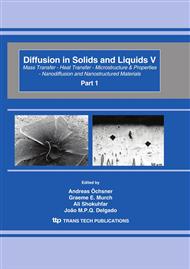p.1065
p.1071
p.1077
p.1083
p.1091
p.1097
p.1103
p.1109
p.1116
Alloying Effects on the Hydrogen Diffusivity during Hydrogen Permeation through Nb-Based Hydrogen Permeable Membranes
Abstract:
The hydrogen solubility and the hydrogen permeability have been measured for Nb-based alloys in order to investigate the alloying effects on the hydrogen diffusivity during hydrogen permeation. The hydrogen diffusion coefficient during hydrogen permeation is estimated from a linear relationship between the normalized hydrogen flux, , and the difference of hydrogen concentration, C, between the inlet and the outlet sides of the membrane. It is found that the hydrogen diffusion coefficient during the hydrogen permeation is increased by alloying ruthenium or tungsten into niobium. On the other hand, the activation energy for hydrogen diffusion in pure niobium under the practical permeation condition is much higher than the reported values measured for dilute hydrogen solid solutions. It is interesting that the activation energy for hydrogen diffusion decreases by the addition of ruthenium or tungsten into niobium.
Info:
Periodical:
Pages:
1091-1096
Citation:
Online since:
April 2010
Price:
Сopyright:
© 2010 Trans Tech Publications Ltd. All Rights Reserved
Share:
Citation:


